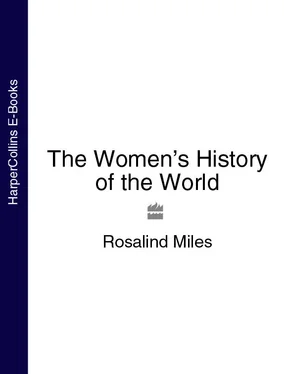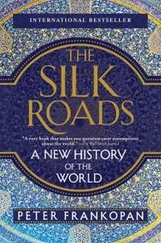Rosalind Miles - The Women’s History of the World
Здесь есть возможность читать онлайн «Rosalind Miles - The Women’s History of the World» — ознакомительный отрывок электронной книги совершенно бесплатно, а после прочтения отрывка купить полную версию. В некоторых случаях можно слушать аудио, скачать через торрент в формате fb2 и присутствует краткое содержание. Жанр: unrecognised, на английском языке. Описание произведения, (предисловие) а так же отзывы посетителей доступны на портале библиотеки ЛибКат.
- Название:The Women’s History of the World
- Автор:
- Жанр:
- Год:неизвестен
- ISBN:нет данных
- Рейтинг книги:5 / 5. Голосов: 1
-
Избранное:Добавить в избранное
- Отзывы:
-
Ваша оценка:
- 100
- 1
- 2
- 3
- 4
- 5
The Women’s History of the World: краткое содержание, описание и аннотация
Предлагаем к чтению аннотацию, описание, краткое содержание или предисловие (зависит от того, что написал сам автор книги «The Women’s History of the World»). Если вы не нашли необходимую информацию о книге — напишите в комментариях, мы постараемся отыскать её.
The Women’s History of the World — читать онлайн ознакомительный отрывок
Ниже представлен текст книги, разбитый по страницам. Система сохранения места последней прочитанной страницы, позволяет с удобством читать онлайн бесплатно книгу «The Women’s History of the World», без необходимости каждый раз заново искать на чём Вы остановились. Поставьте закладку, и сможете в любой момент перейти на страницу, на которой закончили чтение.
Интервал:
Закладка:
During the day I shall clothe thee,
Fear not, oh my little one, whom I have raised. 14
Brother? Little one? Who were these lovers of the Goddess, and why are they described in such terms? The answer to this question leads to the clearest indication of the undisputed power of the Goddess that historical evidence affords.
For the Great Mother originally held the ultimate power – the power of the undisputed ruler, that of life and death. Where woman is the divine queen, the king must die. Mythologically and historically, too, the rampant sensuality of the Great Goddess and her taste for blood unite in the archaic but undisputed practice of the killing of the king. ‘King’ is in fact an honorary tide for the male chosen to fuck the Queen-Goddess in a simple re-enactment of the primal drama subsequently described by historians and anthropologists as ‘the sacred marriage’, with the male ‘acting as divine consort’ to the Goddess. But the savage, inexorable logic of the ritual could hardly be more opposed to this weak and anachronistic attempt to dignify the male’s part in the proceedings. For when all life was thought to flow into, through and out of the female, the highest hope of the male was to escape the fate of all the other disposable drones and associate with the deity, even at the price of then being returned to earth.
Mythologically, the ritual sacrifice of the young ‘king’ is attested in a thousand different versions of the story. In these the immortal mother always takes a mortal lover, not to father her child (though children often result) but essentially in exercise and celebration of her womanhood. The clear pattern is of an older woman with a beautiful but expendable youth – Ishtar and Tammuz, Venus and Adonis, Cybele and Attis, Isis and Osiris. In the story of Demeter, the functional motif of the story is even clearer: the bold Iasion ‘lies with’ the corn goddess in the furrow of a cornfield, and dies by thunderbolt immediately afterwards. The lover is always inferior to the Goddess, mortal where she is immortal, young where she is ageless and eternal, powerless where she is all-powerful, and even physically smaller – all these elements combine in the frequent representation of the lover as the Goddess’s younger brother or son. And always, always, he dies. The fate of the lovers of the Great Goddess was well known when Gilgamesh resisted the command of ‘glorious Ishtar’ with the reproach, ‘Which of your lovers did you love for ever? What shepherd of yours pleased you for all time? . . . And if you and I should be lovers, should not I be served in the same fashion as all these others whom you loved once?’ 15
Within recorded history, versions of the killing of the king frequently occur. The goddess Anaitis of Nineveh annually demanded the most beautiful boy as her lover/victim: beautiful with paint, decked with gold ornaments, clothed in red and armed with the double axe of the goddess, he would spend one last day and night in orgiastic sex with her priestesses under a purple canopy in full view of the people, then he was laid on a bed of spices, incense and precious woods, covered with a cloth of gold and set on fire. ‘The Mother has taken him back to her,’ the worshippers chanted. 16In Ireland, the chief priestess of the Great Goddess of the Moon killed the chosen male with her own hands, decapitating him over a silver ‘regeneration’ bowl to catch his blood. The ‘Jutland cauldron’, one of these vessels now in the Copenhagen Museum, gives a graphic illustration of the goddess in action at the height of the sacrificial ceremony. 17
Historic survivals of the killing of the king continued up to the present day. As late as the nineteenth century, the Bantu kingdoms of Africa knew only queens without princes or consorts – the rulers took slaves or commoners as lovers, then tortured and beheaded them after use. The last queen of the Ashanti, according to the outraged reports of British colonial administrators of the Gold Coast, regularly had several dozen ‘husbands’ liquidated, as she liked to wipe out the royal harem on a regular basis and start again. Even where kingship was established, African queens had the power to condemn the king to death, as Frazer recorded, and the right to determine the moment of execution. Other cultures, however, gradually developed substitute offerings: first, the virility of the young male in place of his life, in a ritual castration ceremony widely practised throughout Asia Minor (though note that the Aztecs in Meso-America never made this an either/or, until the end of their civilization insisting on both ); then in place of men, taking children, animals, even doll-figures of men like the ‘mannikins’ the Vestal Virgins drowned in the Tiber every spring. 18
In real terms, however, the average man does not seem to have had much to fear from the Goddess or her worship. In a culture where the supreme deity is female, the focus is on women, and society draws its structures, rhythms, even colours from them. So, for instance, the special magic of women’s sexuality, from her mysterious menstruation to her gift of producing new life, is expressed in the widespread practice throughout the period of Goddess-worship of treating certain sacred grave-burials with red ochre. Strong or bright red is associated in many religions with female genital blood, while the link between red ochre and blood is clearly indicated by its other name of ‘haematite’. With the red ochre, then, the worshippers of the Goddess were invoking for their dead a symbolic rebirth through the potent substance of menstruation and childbirth. The literal as well as symbolic value of women’s menstrual blood, their ‘moon-gift from the Goddess’, is demonstrated in the ancient Greek custom of mixing it with seed-corn for the annual sowing, to provide ‘the best possible fertilizer’. 19
This open veneration of women’s natural rhythms and monthly flow contrasts strangely with the secret shame and ‘curse’ they later became. But when God was a woman, all women and all things feminine enjoyed a higher status than has ever been since in most countries of the world. Where the Goddess held sway, women did so too. Does this mean then that there was ever a time when women ruled men – when the natural and unquestioned form of government was matriarchy?
‘The age of queens’ – what is the historical truth behind the persistent myths of women holding power over men? Approaches to this question have been dogged by historians’ search for societies where women had total control, and where the men were downgraded and oppressed as an inevitable consequence – for a mirror-image of every patriarchy, in fact. Not surprisingly, this process of going backwards through the looking glass has failed to produce any concrete results. Another will o’ the wisp was the conviction of nineteenth-century scholars that matriarchy had once been a universal stage in world culture, when, the argument ran, as human society emerged from animal promiscuity, women succeeded in bringing about matriarchy through the defeat of their lustful males. In the social order thus created, woman held primacy at every level from human to divine, and the excluded males, uncivilized and violent, lurked about on the fringes of each individual ‘gynocracy’ plotting furious revenge. For matriarchy was only a stage of human ascent towards civilization. Ultimately (and quite logically to the mind of the male historian) the males contrived to overthrow matriarchy and institute patriarchy, the ultimate stage of civilization and its finest flower. 20
Feminist historians could hardly be expected to take all this in the missionary position. Simone de Beauvoir explosively put the boot in as early as 1949:
The Golden Age of woman is only a myth . . . Earth Mother, Goddess – she was no fellow creature in his eyes; it was beyond the human realm that her power was confirmed, and she was therefore outside that realm. Society has always been male; political power has always been in the hands of men. 21
Читать дальшеИнтервал:
Закладка:
Похожие книги на «The Women’s History of the World»
Представляем Вашему вниманию похожие книги на «The Women’s History of the World» списком для выбора. Мы отобрали схожую по названию и смыслу литературу в надежде предоставить читателям больше вариантов отыскать новые, интересные, ещё непрочитанные произведения.
Обсуждение, отзывы о книге «The Women’s History of the World» и просто собственные мнения читателей. Оставьте ваши комментарии, напишите, что Вы думаете о произведении, его смысле или главных героях. Укажите что конкретно понравилось, а что нет, и почему Вы так считаете.










